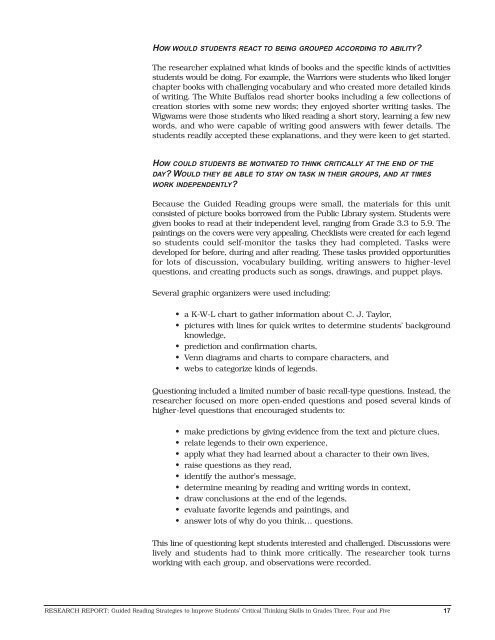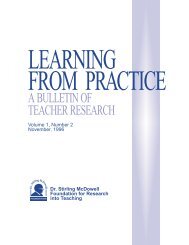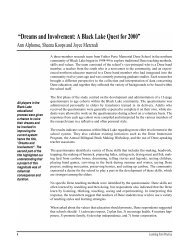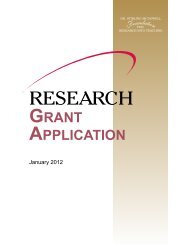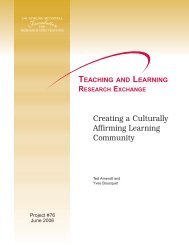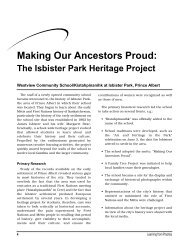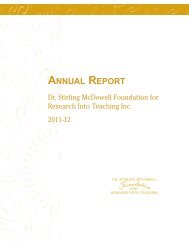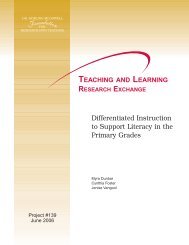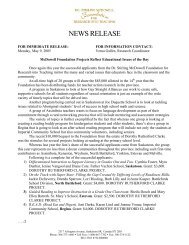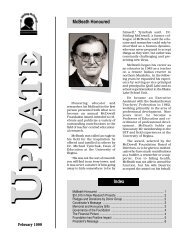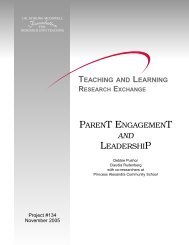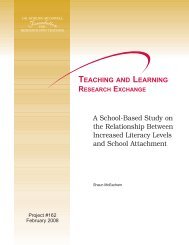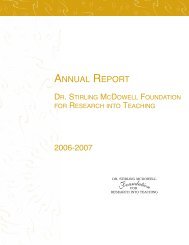Guided Reading Strategies to Improve Students - Dr. Stirling ...
Guided Reading Strategies to Improve Students - Dr. Stirling ...
Guided Reading Strategies to Improve Students - Dr. Stirling ...
- No tags were found...
Create successful ePaper yourself
Turn your PDF publications into a flip-book with our unique Google optimized e-Paper software.
HOW WOULD STUDENTS REACT TO BEING GROUPED ACCORDING TO ABILITY?The researcher explained what kinds of books and the specific kinds of activitiesstudents would be doing. For example, the Warriors were students who liked longerchapter books with challenging vocabulary and who created more detailed kindsof writing. The White Buffalos read shorter books including a few collections ofcreation s<strong>to</strong>ries with some new words; they enjoyed shorter writing tasks. TheWigwams were those students who liked reading a short s<strong>to</strong>ry, learning a few newwords, and who were capable of writing good answers with fewer details. Thestudents readily accepted these explanations, and they were keen <strong>to</strong> get started.HOW COULD STUDENTS BE MOTIVATED TO THINK CRITICALLY AT THE END OF THEDAY? WOULD THEY BE ABLE TO STAY ON TASK IN THEIR GROUPS, AND AT TIMESWORK INDEPENDENTLY?Because the <strong>Guided</strong> <strong>Reading</strong> groups were small, the materials for this unitconsisted of picture books borrowed from the Public Library system. <strong>Students</strong> weregiven books <strong>to</strong> read at their independent level, ranging from Grade 3.3 <strong>to</strong> 5.9. Thepaintings on the covers were very appealing. Checklists were created for each legendso students could self-moni<strong>to</strong>r the tasks they had completed. Tasks weredeveloped for before, during and after reading. These tasks provided opportunitiesfor lots of discussion, vocabulary building, writing answers <strong>to</strong> higher-levelquestions, and creating products such as songs, drawings, and puppet plays.Several graphic organizers were used including:• a K-W-L chart <strong>to</strong> gather information about C. J. Taylor,• pictures with lines for quick writes <strong>to</strong> determine students’ backgroundknowledge,• prediction and confirmation charts,• Venn diagrams and charts <strong>to</strong> compare characters, and• webs <strong>to</strong> categorize kinds of legends.Questioning included a limited number of basic recall-type questions. Instead, theresearcher focused on more open-ended questions and posed several kinds ofhigher-level questions that encouraged students <strong>to</strong>:• make predictions by giving evidence from the text and picture clues,• relate legends <strong>to</strong> their own experience,• apply what they had learned about a character <strong>to</strong> their own lives,• raise questions as they read,• identify the author’s message,• determine meaning by reading and writing words in context,• draw conclusions at the end of the legends,• evaluate favorite legends and paintings, and• answer lots of why do you think… questions.This line of questioning kept students interested and challenged. Discussions werelively and students had <strong>to</strong> think more critically. The researcher <strong>to</strong>ok turnsworking with each group, and observations were recorded.RESEARCH REPORT: <strong>Guided</strong> <strong>Reading</strong> <strong>Strategies</strong> <strong>to</strong> <strong>Improve</strong> <strong>Students</strong>’ Critical Thinking Skills in Grades Three, Four and Five17


